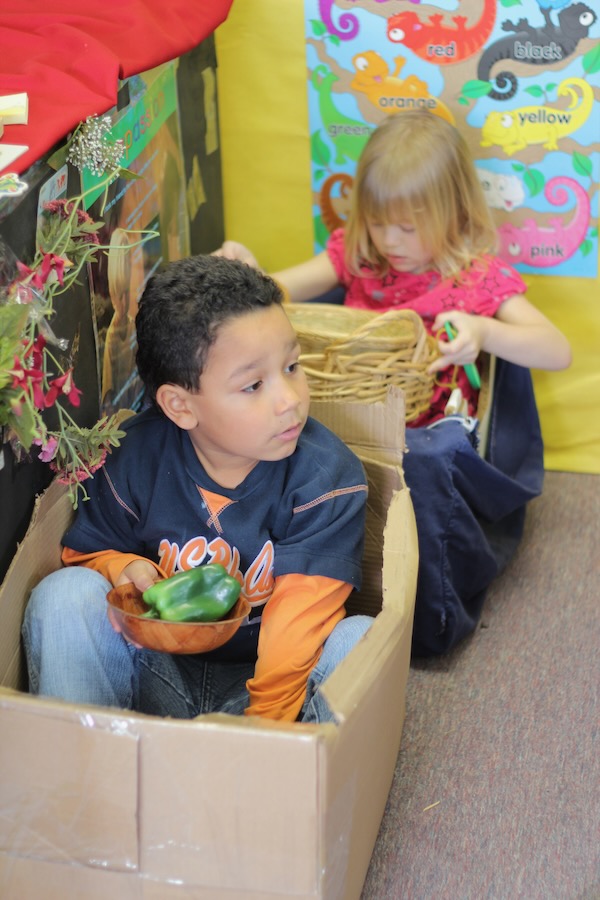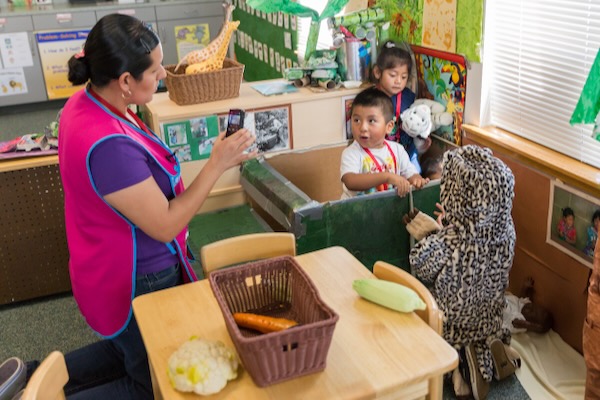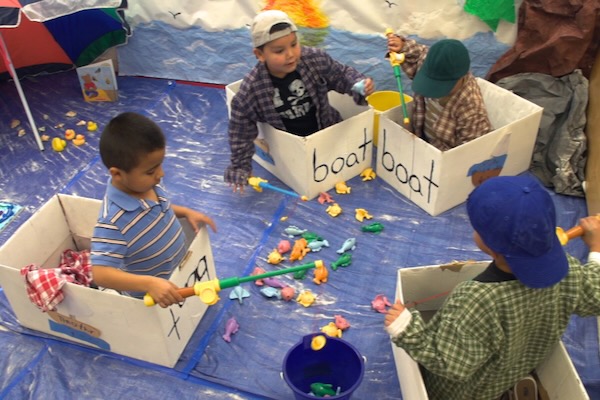Try it out!
Looking for free or low-cost fun ways to engage children? Educators and families can use cardboard boxes to spark children’s imaginations. While adults may see a cardboard box as an everyday object, it holds numerous possibilities in the eyes of a child. Open-ended materials like boxes offer children opportunities to express their creativity and imagination. Children build science, technology, engineering, art, and math (STEAM) skills as they choose materials to imagine, create, and test and implement their ideas. So, what’s in the box? Endless possibilities!
Be intentional in your exploration.
- Encourage infants and toddlers to explore textures on boxes, for example, grooved ridges and smooth or slippery surfaces.
- Describe what they discover using vocabulary and comparison words like smooth or rough, soft or hard, big or small, and scratchy or sticky.
- Offer a selection of boxes for children to create structures or art projects.
- Show value for children’s creations by allowing extended time for creating and offer opportunities to return to projects if needed.
- Respond to children’s work in a way that is objective and encourages children to describe what they’ve done:
- Tell me what you are working on.
- You made some interesting structures with this box, tell me about them.
- Model using descriptive language about the textures, sounds, and smells of the materials that infants and toddlers are exploring. Encourage older children to describe their box creations.
- Connect creations with boxes to other areas of play and learning like adding structures to dramatic play or blocks.
- Use large cardboard boxes to make cozy reading nooks, quiet areas, or sensory play spaces. Place a few soft items inside or add textured materials for children to explore with their senses. This approach can help children who might benefit from a calming environment.
Gather materials to support your box play.

- Provide children with different sizes of boxes, ranging from small to large.
- Create open-ended loose parts collections to use in decorating boxes, including wood reuse, plastic caps, packaging/cardboard, and natural materials for creative projects. Home visitors can help families collect loose parts, plan for storage, and use them in ways that fit families’ homes.
- Make a variety of collage materials available and accessible for children’s independent use for decorating boxes, such as markers, paints, glue, tape, construction paper, ribbon, and fabric scraps. Ask children to share their ideas for additional materials.
- Make space in your environment for large and small box creations.
- Cardboard boxes can be decorated and used to act out scenes from books or create storytelling props. They make wonderful “story boxes” that can hold items for retelling stories, which improves understanding, vocabulary, and speaking skills.
- Large cardboard boxes can create a theater for puppet shows to support language development.
Consider adaptations that help everyone engage.
- As you prepare your spaces, make sure there is enough room for all children to engage in box play activities and still move around safely.
- Ensure that all children can participate in box activities by creating lower or higher work surfaces as needed.
- Choose materials of different sizes and shapes.
- Provide various types of scissors, such as training scissors, loop scissors, and spring-action scissors for cutting different types of materials used to decorate boxes.
- Invite families to share information about their cultural crafts, suggest activity ideas, or share examples of creations reflective of their culture.
- Use a mixture of simple and complex descriptive language so children hear a variety of words and phrases they can use to what they are feeling, seeing, hearing, or smelling. Words like fluffy, smooth, and rough help children describe sensory experiences and can bring joy to the activity!
- Encourage children to play with language. They can make up their own words and use their home or Indigenous language to describe their play activities with boxes. For example, if your program includes children who speak Spanish, you might help them label their dramatic play as the “Casa de Caja” or “box house” to support their dramatic play boxes.
- Support emerging pretend play by creating a cozy, quiet space to share with a baby, or creating a tunnel for children learning to crawl. Pretend play for preschool-aged children may include boxes transforming into a boat or car.
Look for connections to the Head Start Early Learning Outcomes Framework (ELOF) goals shown below. Adapt this activity to connect with any domain.
- Infant-Toddler Perceptual, Motor, and Physical Development 1: Child uses perceptual information to understand objects, experiences, and interactions.
- Infant-Toddler Language and Communication 2: Child learns from communication and language experiences with others.
- Preschool Perceptual, Motor, and Physical Development 3: Child demonstrates increasing control, strength, and coordination of small muscles.
- Preschool Approaches to Learning 12: Child expresses creativity in thinking and communication.

Connect and Extend
Create a culture of inquiry by asking great questions.
One strategy for extending conversations with children is to ask meaningful questions like, "What do you think will happen next?" Open-ended questions with many possible answers allow children to express their ideas, provide explanations, and make predictions. For some children, especially infants and toddlers, this may involve giving them time to think, observing their nonverbal responses, and then prompting or labeling their gestures.
- Can you tell me about your box fort? What will you do in it?
- How did you decide what to make? Did you have a plan?
- Can you show me how you made this part?
- How did you feel when you were making this? Was it fun or difficult?
- What is your favorite part of your fort?
Develop creative connections and be a “good relative.”
What does it mean to be a good relative? In many American Indian and Alaska Native cultures, being a good relative is a way to describe treating others, the land, and all living creatures with care, kindness, and respect. It is a practice we want to encourage in all children and adults, inclusive of all cultural backgrounds.
We are all related and connected. How does this connection extend into providing boxes for children to explore? Teach children about reusing and recycling by introducing boxes in a classroom or home. Encourage children to repurpose boxes for different projects, emphasizing sustainability and helping them develop a respect for the environment.
Honor children’s ideas and ways of being and empower them to lead their own learning experience and exploration. Engage families in planning and include their culture and home or Indigenous language. During play, children learn about positive connections to each other. As they get older, they also engage in cooperative play and learn to use their problem-solving skills to resolve conflicts with others. With the support of familiar adults, children can:
- Begin building cooperative play skills,
- Recognize and interpret the emotions of others, and
- Express care and concern toward others in play and learning settings.
Take a Look
It’s Time for Play! Building Forts
When children build forts, they learn gross motor and engineering skills. Watch this video to find some new ways to build forts with children of all ages. This video shows the use of blankets, but using boxes can be another great way to make a fort!
Digging Deeper into Why Sensory Play Matters
- Creativity is an important skill that is strengthened through practice. Young children are excellent creative problem solvers. In certain contexts, children are better at creative, flexible thinking than adults. Providing open-ended arts activities using boxes and other materials helps young children build and maintain their creativity.
- Children (and adults!) learn best in environments that are meaningful. As children explore and create, they make connections between their own thoughts and the world around them. By using boxes in role play, children can explore different scenarios and practice many skills, including social and language skills. Engage families in conversations and planning to spark ideas to connect culture, home, and Indigenous language.
- Brain development drives behavior. Over the course of childhood, the brain builds connections that support skills, including self-regulation. Warm, caring relationships support those strong, positive connections in the brain. Genes, culture, ability level, and experience all contribute to how children manage their emotions and behavior. Strong self-regulation skills relate to more positive behavior and better school readiness. It's easier for children to engage in learning when they can self-regulate. For example, you can set up a calming corner, including boxes filled with blankets and pillows, where children can choose to play with soft materials and toys, books, sensory items, or self-regulation materials. Adults can help children co-regulate and help them learn to visit this area to self-regulate.
- Curiosity sparks our motivation and learning. Children are naturally curious and excited to learn. Curiosity and initiative promote a child's growing independence as a learner. When we learn about something that makes us curious, we are more likely to remember it.
- Children learn how to learn through play. When children play, they can explore as they choose. Open-ended and pretend play using boxes can support children’s desire to explore as they choose. Children can use their imagination and creativity, focus their attention, and follow their curiosities while also developing confidence in their abilities. Children who pretend play more often tend to show better self-control. How you support children's learning—through materials like boxes, activities, and hands-on support—may look different depending on a child's unique characteristics.

Read About It
Creative Learning Environments
This Research on the Go podcast reviews key considerations for building environments that support infant and toddler creativity. It focuses on how programs help children foster creative skills by designing environments that are flexible, open-ended, and meaningful.
Joy for the Journey
“The playing adult steps sideward into another reality; the playing child advances forward to new stages of mastery." — Erik Erikson
Read more:
Resource Type: Article
National Centers: Early Childhood Development, Teaching and Learning
Audience: Teachers and Caregivers
Last Updated: June 12, 2025